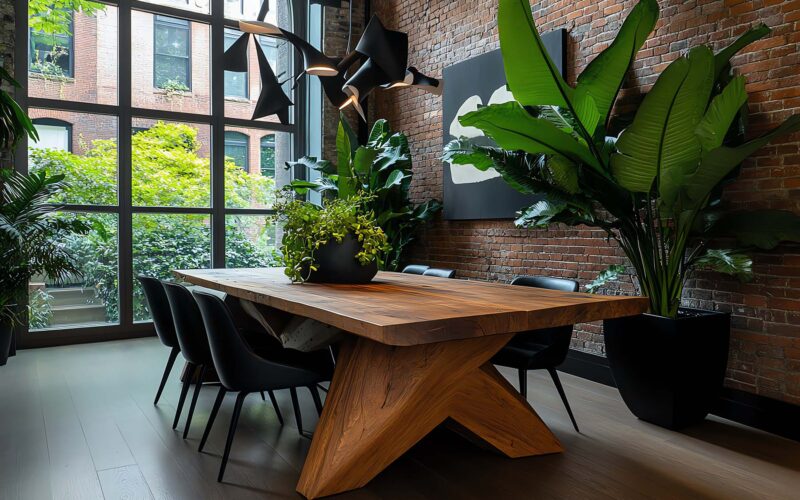I want to let you in on a little secret: big, beautiful indoor plants are the key to transforming your home into a lush, green oasis. And the best part? You don’t need a green thumb to pull it off!
My journey through a jungle of giant interior plants spans several years – now it’s time to spill on which ones stole my heart. These leafy wonders will instantly elevate your space, purify your air, and make you feel like you’re living in a tropical paradise (minus the humidity, of course).
No matter if you’ve got the magic touch with plants or if this is all new territory for you, get set to be wowed by some seriously low-effort beauties. Believe me, your house will be grateful.
Table of Contents:
- 10 Best Large Indoor Plants for Your Home
- Fiddle Leaf Fig (Ficus Lyrata)
- Rubber Plant (Ficus Elastica)
- Snake Plant (Sansevieria Trifasciata)
- Monstera Deliciosa (Swiss Cheese Plant)
- Dracaena Fragrans (Corn Plant)
- Weeping Fig (Ficus Benjamina)
- Parlor Palm (Chamaedorea Elegans)
- ZZ Plant (Zamioculcas Zamiifolia)
- Money Tree (Pachira Aquatica)
- Kentia Palm (Howea Forsteriana)
- Conclusion
- FAQs in Relation to Best Large Indoor Plants
10 Best Large Indoor Plants for Your Home
The best large house plants bring life to our spaces, purify our air, and make us feel good. Studies show having indoor plants around your home reduces stress and anxiety. I’ve been obsessed with big, beautiful indoor plants for years now. My home is filled with them – a rubber plant in the living room, a majestic fiddle leaf fig in the bedroom, snake plants livening up corners. I can’t imagine my space without these green friends.
If you’re looking for the best large indoor plants to transform your home into a lush oasis, look no further. These 10 varieties are the créme de la créme:
- Fiddle Leaf Fig
- Rubber Plant
- Snake Plant
- Swiss Cheese Plant
- Corn Plant
- Weeping Fig
- Parlor Palm
- ZZ Plant
- Money Tree
- Kentia Palm
These aren’t just any old house plants. They’re statement pieces, conversation starters, instant mood-boosters. I can’t wait to dive into each one and share why they deserve a spot in your home.
Fiddle Leaf Fig (Ficus Lyrata)

Let’s start with the unrivaled queen of the indoor jungle – the fiddle leaf fig. This trendy plant has skyrocketed to fame in recent years, and for good reason. With its large, glossy violin-shaped leaves, it’s a sculptural work of art. I’ll never forget the day I brought home my first fiddle leaf fig. I gave it the sunniest spot in my apartment, and watched in awe as it grew over 6 feet tall. The key to keeping a fiddle leaf fig happy is bright, indirect light. These are not low-light plants – they need those rays to support their big, beautiful leaves. Mine gets a few hours of direct sun each morning and indirect light the rest of the day.
If you want to level up your home decor game, adopt a fiddle leaf fig. With the right care, it’ll grow into a towering tree that makes you feel like you’re living in a magazine spread. Trust me.
Rubber Plant (Ficus Elastica)

Next up, we have the rubber plant, aka the fiddle leaf fig’s tough-as-nails cousin. With its thick, glossy leaves in shades of dark green and burgundy, this plant oozes sophistication. What I love about rubber plants is how adaptable they are. They can tolerate lower light than most of their finicky ficus relatives. I have one in a north-facing room that gets no direct sun, and it’s thriving.
The dark leaves look almost black in the dim light, adding to the moody vibe. Rubber plants also have an amazing leaf texture. The leaves are so thick and waxy, they almost don’t feel real. It’s like having a plant made of plastic, but better, because it’s alive and growing. One thing to watch out for with rubber plants is their sap. It can irritate skin and cause stains, so wear gloves when pruning or wash your hands right after. A little sap is a small price to pay for such a stunning plant, if you ask me.
Snake Plant (Sansevieria Trifasciata)
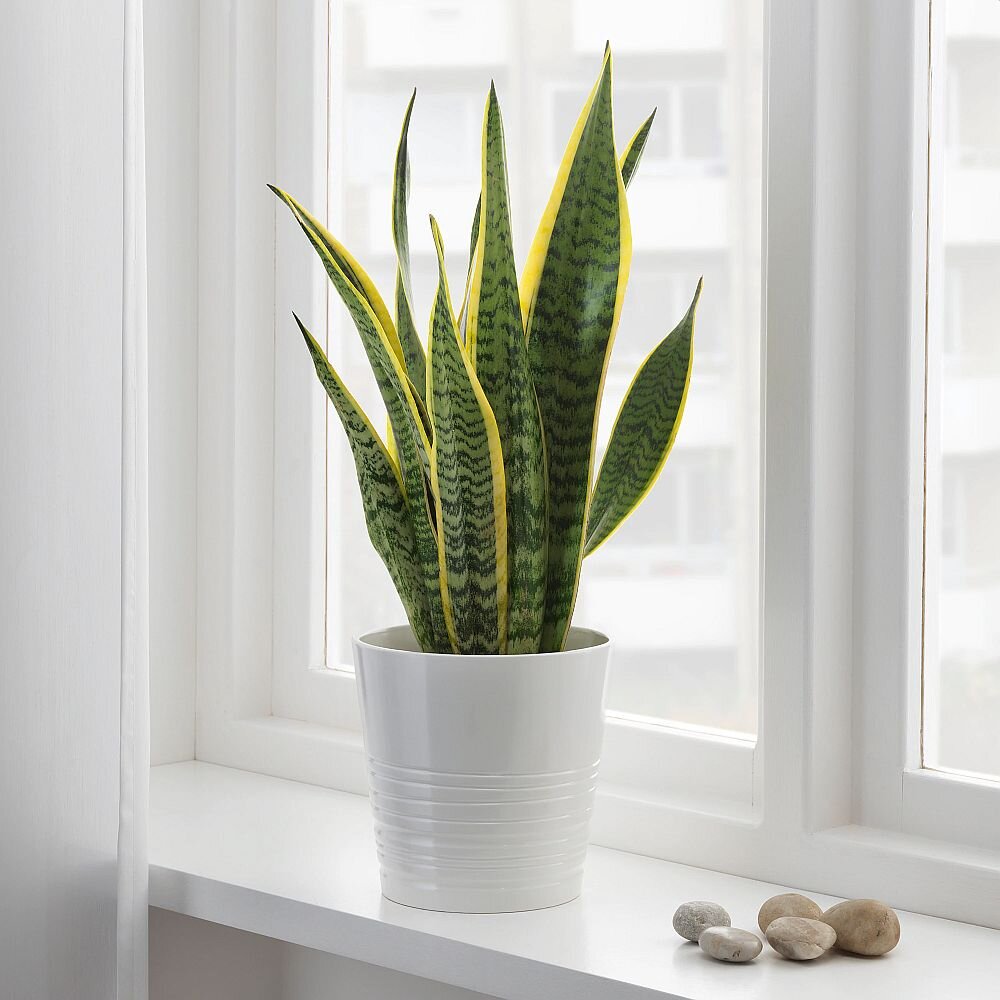
If you’re more of a plant neglecter than a helicopter plant parent, meet the snake plant. This succulent thrives, even with neglect. Seriously, it’s harder to kill than to keep alive. Snake plants are the ultimate low-light champions. They’ll tolerate pretty much any light level, from a sunny window to a dark basement. I have one in my windowless bathroom, and it’s been going strong for years. Not only do they survive in less-than-ideal conditions, but snake plants also improve your air quality. A NASA study found they’re one of the best plants for filtering out toxins like formaldehyde and benzene. Breathe easy knowing this sharp-looking plant has your back.
With their striking, sword-like leaves and architectural form, snake plants are a feast for the eyes. They come in a range of patterns, from solid green to silver-streaked. Mix and match different varieties for an eye-catching display. I have snake plants all over the house, with varying sizes and patterns to match the setting. One of the things I love about these plants is that you can split them! I bought a few, and over time split and repotted them, so now I have over ten snake plants around the house. I’ve even gifted some of the smaller ones to friends and family that want an easy plant to add some life and greenery to their home.
Swiss Cheese Plant (Monstera Deliciosa)
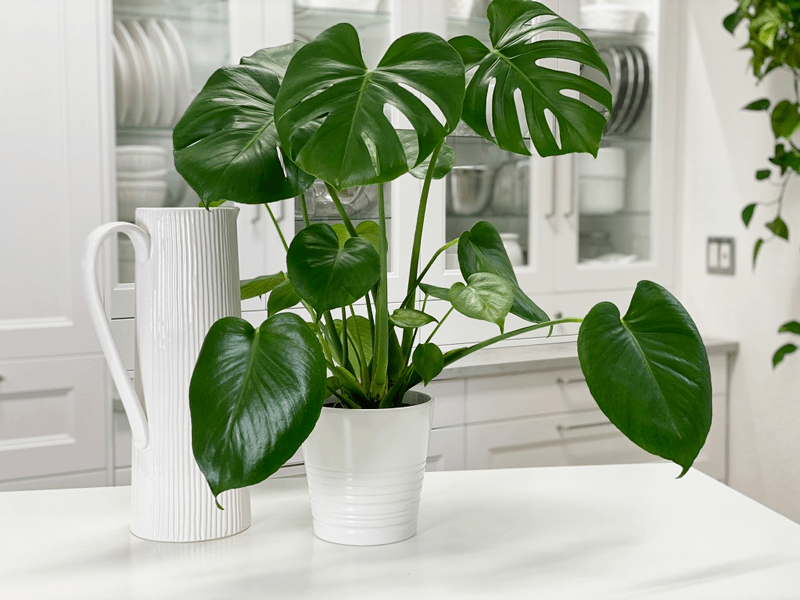
This tropical stunner, also known as the Swiss cheese plant, is the darling of the design world. And for good reason – just look at the leaves. Monsteras are all about the foliage. Their leaves can grow up to 3 feet long, punctuated by dramatic holes that earned them the nickname “Swiss cheese.” It’s like having art growing right in your living room.
Like the fiddle leaf fig, monsteras thrive in bright, indirect light. They’re a bit easier to care for, though – more forgiving of missed waterings and less prone to dropping leaves in a huff. I have mine in an east-facing window, where it gets a few hours of gentle morning sun. One of the coolest things about monsteras is watching new leaves unfurl. They emerge tightly furled, like little green scrolls, then slowly open to reveal their quirky cutouts. Each new leaf feels like unwrapping a present.
Corn Plant (Dracaena Fragrans)
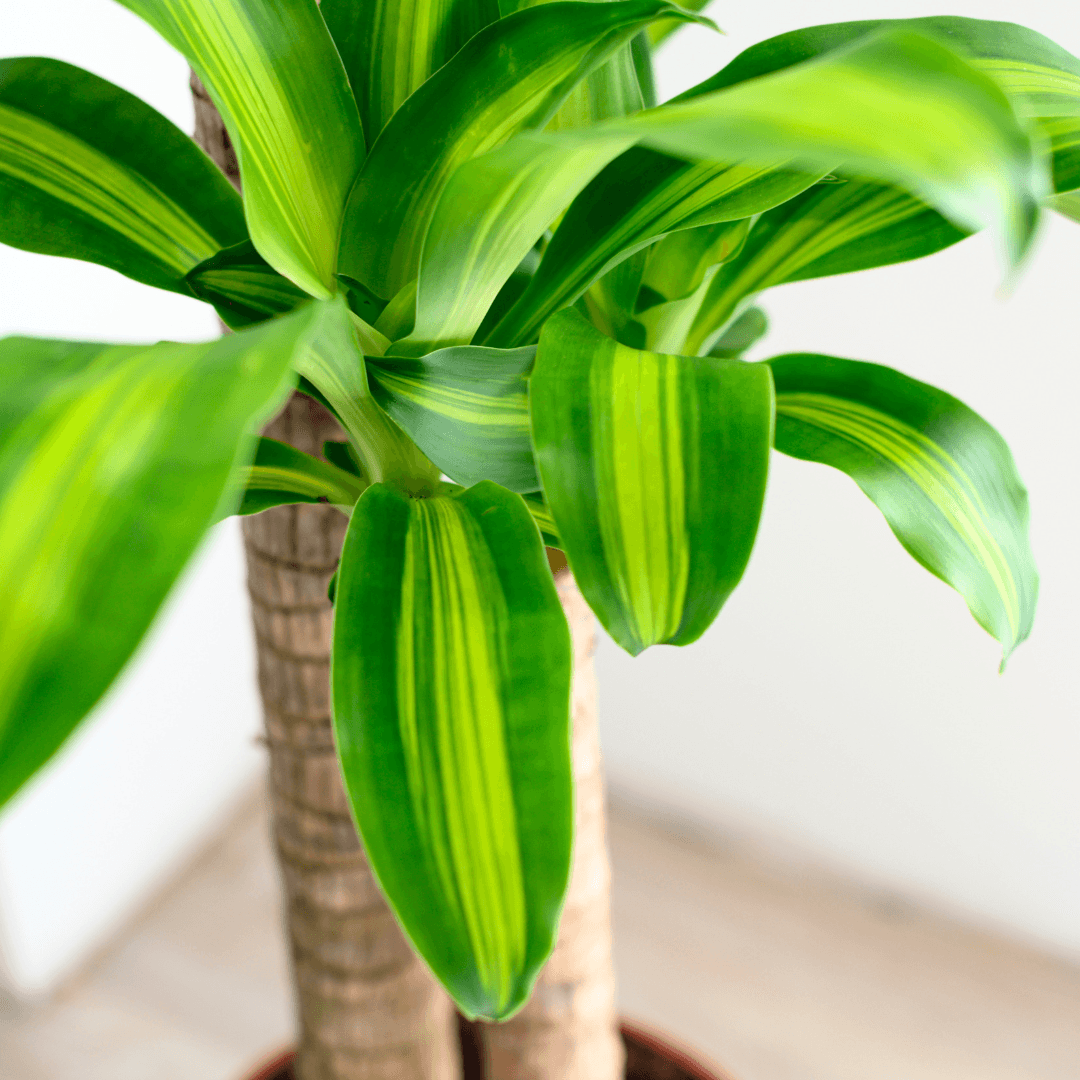
This underrated gem is like the snake plant’s laid-back cousin. It thrives in low light, shrugs off neglect, and looks darn good doing it. Corn plants get their name from their arching leaves, which resemble corn stalks. They can grow up to 6 feet tall indoors, making them a perfect floor plant to fill an empty corner. I love how their leaves add a pop of bright green to a neutral room.
While they can handle low light, corn plants do best in medium indirect light. They’re not too demanding, but they’ll grow faster and fuller in a brighter spot. Water when the top inch of soil feels dry, and you’re good to go. One of my favorite things about corn plants is their subtle fragrance. Some varieties have a sweet, almost citrusy scent that wafts through the room on a warm day. It’s like a little aromatherapy bonus.
Weeping Fig (Ficus Benjamina)
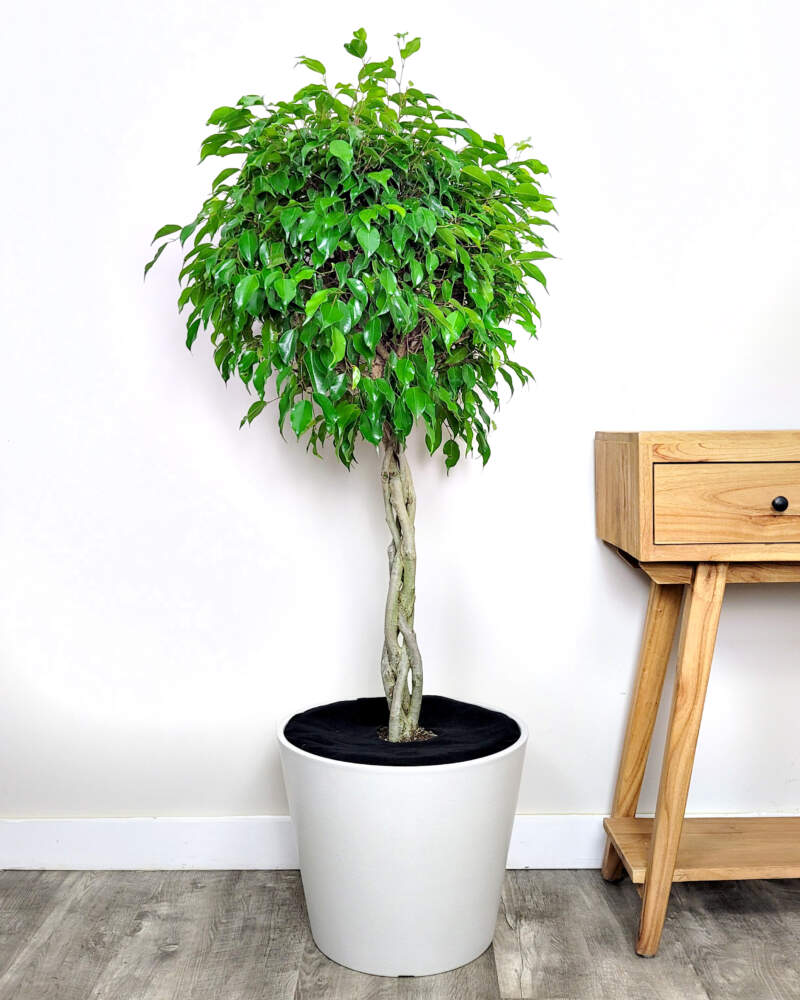
If you’re looking for a large indoor plant that’s a real showstopper, look no further than the Weeping Fig (Ficus Benjamina). This ficus plant is a popular choice for home and office spaces, thanks to its lush, green foliage and tolerance for bright, indirect light.
I remember when I first brought home my Weeping Fig. I was a little nervous about caring for such a large plant, but I quickly learned that with the right conditions, this beauty thrives. The key is to provide it with plenty of bright, indirect light and to keep the soil consistently moist (but not soggy).
One thing to keep in mind with the Weeping Fig is that it can be a bit of a diva when it comes to changes in its environment. If you move it to a new location or there’s a sudden shift in temperature or humidity, don’t be surprised if it drops a few leaves. But don’t worry – this is totally normal, and your plant will bounce back in no time.
Overall, if you’re looking for a large house plant that makes a statement and can handle a variety of light conditions, the Weeping Fig is a great choice. Just be sure to keep an eye on its soil moisture and be patient with any minor leaf drop, and you’ll have a stunning addition to your indoor jungle in no time.
Parlor Palm (Chamaedorea Elegans)
:max_bytes(150000):strip_icc()/grow-chamaedorea-indoors-1902884-1-ccf2df16fb51494ca78df7f510372219.jpg)
When it comes to tall indoor plants that can thrive in low light conditions, the Parlor Palm (Chamaedorea Elegans) is a top contender. This elegant palm has been a popular houseplant since Victorian times, and it’s easy to see why.
One of the best things about the Parlor Palm is its ability to purify the air. According to a NASA study , this plant is effective at removing indoor air pollutants like benzene and formaldehyde. So not only does it add a tropical touch to your home, but it also helps improve air quality.
I’ve had my Parlor Palm for years, and it’s been a reliable, low-maintenance addition to my home. It’s happiest in a spot with low to medium light, and it only needs watering when the top inch of soil feels dry. I love how it adds a lush, green element to any room without demanding too much attention.
If you’re looking for a tall indoor plant that can handle low light conditions and improve your air quality, the Parlor Palm is definitely worth considering. With its elegant fronds and easygoing nature, it’s a classic choice that never goes out of style.
ZZ Plant (Zamioculcas Zamiifolia)
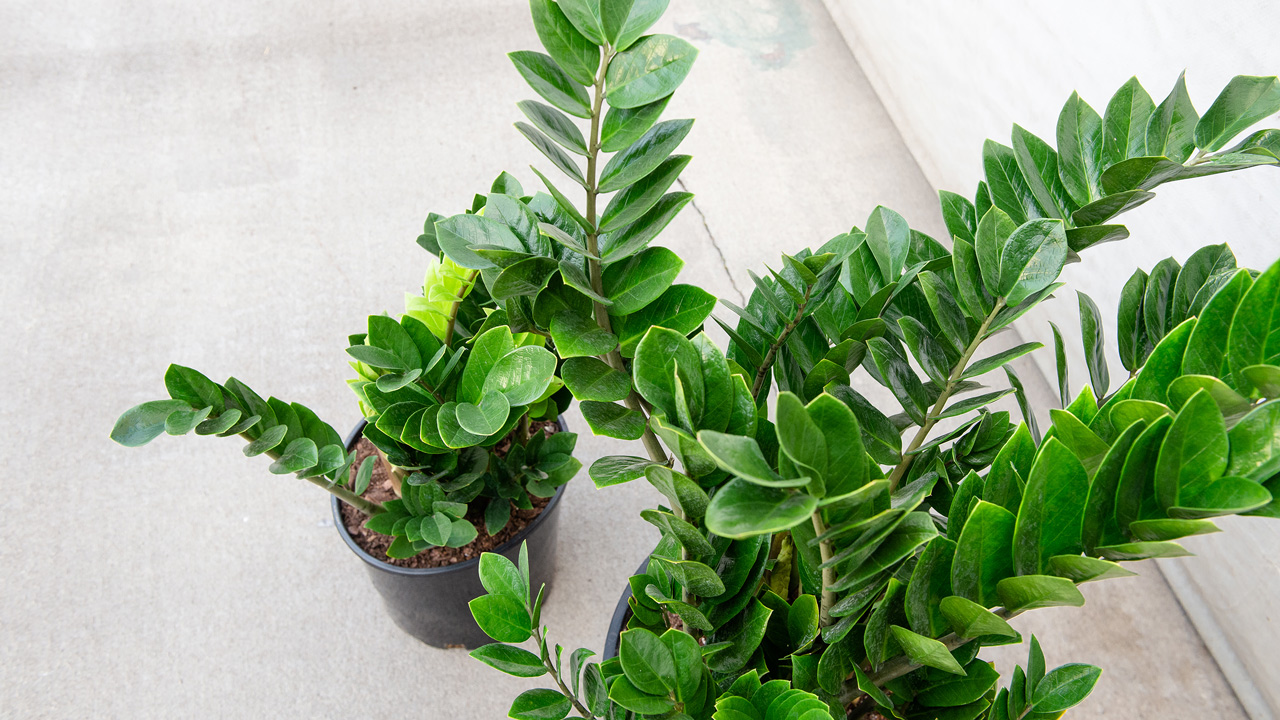
If you’re a beginner plant parent or have a space with low light conditions, the ZZ Plant (Zamioculcas Zamiifolia) is a must-have. This large house plant is practically indestructible, thriving in even the darkest rooms of your home.
I first discovered the ZZ Plant when I was looking for a low-maintenance option for my office, which has no windows. I was skeptical that anything could survive in such a dark space, but the ZZ Plant proved me wrong. It’s been happily growing in my office for years now, with virtually no effort on my part.
One of the coolest things about the ZZ Plant is its unique, glossy leaves. They have an almost waxy texture that makes them look artificial (in a good way.). And because this plant is so tolerant of low light and infrequent watering, it’s a great choice for anyone who wants the look of a large indoor plant without the fuss.
If you’re considering adding a ZZ Plant to your collection, just be sure to let the soil dry out completely between waterings. Overwatering is one of the few things that can kill this hardy plant. But otherwise, sit back and enjoy its lush, green presence in even the darkest corners of your home.
Money Tree (Pachira Aquatica)

Looking for a large indoor plant that’s both beautiful and believed to bring good luck and fortune? Look no further than the Money Tree (Pachira Aquatica). This unique plant features a braided trunk and glossy green leaves that are sure to make a statement in any room.
One thing to keep in mind with the Money Tree is that it does best in bright, indirect light. I have mine near a window that gets plenty of light, but I’m careful to keep it out of direct sunlight, which can scorch its leaves. I also make sure to let the soil dry out a bit between waterings to avoid overwatering.
If you’re looking for a large house plant that’s a little out of the ordinary and believed to bring good fortune, the Money Tree is a great choice. With its braided trunk and lush, green leaves, it’s sure to add a touch of whimsy and luck to any space.
Kentia Palm (Howea Forsteriana)

If you’re looking for a tall indoor plant that can handle a variety of light conditions, the Kentia Palm (Howea Forsteriana) is a great option. This elegant palm is native to Australia and can grow up to 10 feet tall in the right conditions.
I have a Kentia Palm in my living room, and it’s been a beautiful addition to the space. It’s near a window that gets bright, indirect light for most of the day, and it seems to be thriving. I love how its long, arching fronds add a tropical touch to the room and make the space feel more inviting.
One thing to keep in mind with the Kentia Palm is that it does prefer slightly humid conditions. I mist mine regularly and keep it away from air vents or drafty areas that could dry it out. I also make sure to keep the soil consistently moist (but not soggy) and fertilize it every few months during the growing season.
Overall, if you’re looking for a tall indoor plant that can handle bright, indirect light and add a touch of elegance to your space, the Kentia Palm is definitely worth considering. With its lush, feathery fronds and easygoing nature, it’s a classic choice that never goes out of style.
Key Takeaway:
Want to green up your space with large indoor plants? The Weeping Fig and Parlor Palm are great for bright areas, while the ZZ Plant thrives in low light. Don’t forget the lucky Money Tree and elegant Kentia Palm, which both add a unique touch. Just remember: proper light and watering are key.
Conclusion
Bringing the best large indoor plants into your home is a game-changer. Not only do they add a touch of natural beauty to your space, but they also help purify the air and create a calming, zen-like atmosphere.
From the striking fiddle leaf fig to the nearly indestructible snake plant, there’s a perfect large indoor plant for every style and skill level. And with a little TLC, these green giants will thrive and become a beloved part of your home for years to come.
So go ahead, pick your favorite (or two, or three…) and start your journey to creating an indoor jungle that will be the envy of all your friends. Your home will never be the same – in the best way possible.
FAQs in Relation to Best Large Indoor Plants
What is the easiest large plant to grow indoors?
The ZZ Plant thrives, even when neglected. It loves low light and needs minimal water, making it a cinch to keep alive.
What is the best full indoor plant?
The Monstera Deliciosa steals the show with its dramatic leaves. It’s perfect for bright rooms and adds a jungle vibe.
What is the easiest tall house plant to keep alive?
A Snake Plant barely bats an eye at poor lighting or forgetful watering. It stands tall without demanding much back.
What is the longest living houseplant?
Jade Plants can last for decades with proper care, turning into mini trees that outlive many other indoor greens.
